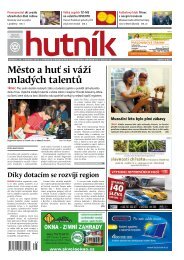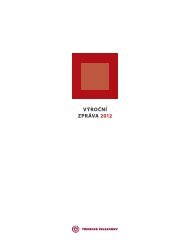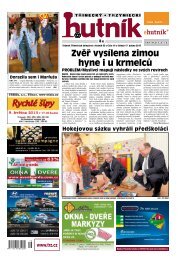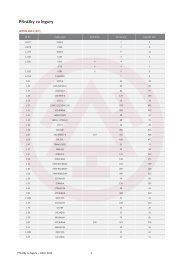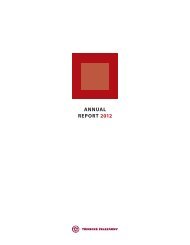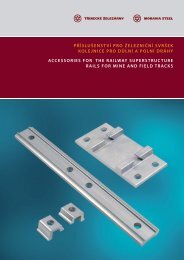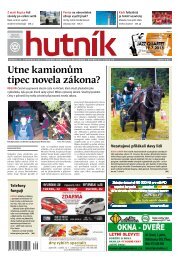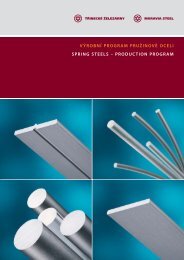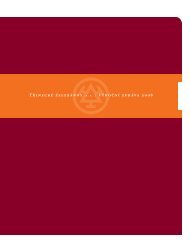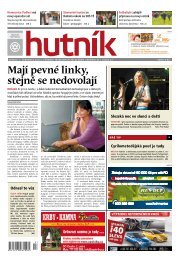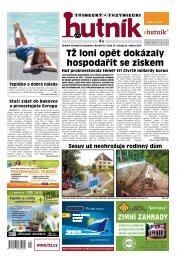TŽ Annual Report 2008 in pdf, 7.5 MB - TÅinecké železárny
TŽ Annual Report 2008 in pdf, 7.5 MB - TÅinecké železárny
TŽ Annual Report 2008 in pdf, 7.5 MB - TÅinecké železárny
- No tags were found...
You also want an ePaper? Increase the reach of your titles
YUMPU automatically turns print PDFs into web optimized ePapers that Google loves.
3. Summary of Significant Account<strong>in</strong>g Policies3.1. Tangible and Intangible Fixed AssetsValuationTangible fixed assets <strong>in</strong>clude assets with a cost greater than CZK 40 thousand on an <strong>in</strong>dividual basis and an estimated useful life greater than one year.Intangible fixed assets <strong>in</strong>clude assets (such as software, valuable rights, and research and development) with a cost greater than CZK 60 thousand on an<strong>in</strong>dividual basis and an estimated useful life greater than one year.Purchased tangible and <strong>in</strong>tangible fixed assets are valued at cost. Tangible and <strong>in</strong>tangible fixed assets developed <strong>in</strong>ternally are valued at direct costs, <strong>in</strong>cidentalcosts directly attributable to the <strong>in</strong>ternal production of assets, or alternatively <strong>in</strong>cidental costs of an adm<strong>in</strong>istrative character if the productionperiod of the assets exceeds one year.The follow<strong>in</strong>g tangible and <strong>in</strong>tangible fixed assets are stated at replacement cost: tangible and <strong>in</strong>tangible fixed assets acquired through donation, <strong>in</strong>tangiblefixed assets <strong>in</strong>ternally generated if replacement cost is lower than <strong>in</strong>ternal costs, assets recently entered <strong>in</strong> the account<strong>in</strong>g records such as an <strong>in</strong>ventorycount surplus (accounted for by a correspond<strong>in</strong>g entry <strong>in</strong> the relevant accumulated depreciation account) and an <strong>in</strong>vestment of <strong>in</strong>tangible and tangiblefixed assets, except for cases where the <strong>in</strong>vestment is valued differently pursuant to a Memorandum of Association or a Foundation Deed.The replacement cost is also applied to tangible fixed assets acquired under f<strong>in</strong>ance lease arrangements with an orig<strong>in</strong>al cost exceed<strong>in</strong>g CZK 1 million.These assets are carried at replacement cost and recorded <strong>in</strong> the statutory books as fully depreciated. Replacement cost is determ<strong>in</strong>ed by an expert appraiseror through an estimate performed under the Companys <strong>in</strong>ternal regulations.Tangible and <strong>in</strong>tangible assets with an estimated useful life greater than one year and a cost equal to or lower than CZK 40 thousand and CZK 60 thousand,respectively, are not treated as fixed assets. Such tangible assets are accounted for as <strong>in</strong>ventory and when brought <strong>in</strong>to use they are charged to Consumedmaterial and energy <strong>in</strong> the profit and loss account. Intangible assets cost<strong>in</strong>g CZK 60 thousand and less are expensed through the account Services<strong>in</strong> the year of acquisition.The cost of a fixed asset improvement exceed<strong>in</strong>g CZK 40 thousand <strong>in</strong>creases the acquisition cost of the related fixed asset.The results of the Companys research and development activities, if designed for trad<strong>in</strong>g or resale, are recognised through the balance sheet l<strong>in</strong>e Researchand development. Research and development results designed for <strong>in</strong>ternal purposes are not classified as <strong>in</strong>tangible fixed assets for f<strong>in</strong>ancial report<strong>in</strong>gpurposes and are held <strong>in</strong> off balance sheet records at <strong>in</strong>ternal costs of production.Greenhouse emission allowances are recognised as non-depreciable <strong>in</strong>tangible fixed assets and are stated at cost, or replacement cost when acquiredfree of charge. The use of emission allowances is accounted for at the balance sheet date as a m<strong>in</strong>imum, depend<strong>in</strong>g upon the level of emissions producedby the Company <strong>in</strong> the calendar year. An <strong>in</strong>itial free-of-charge acquisition of the allowances is recognised as a subsidy not reduc<strong>in</strong>g the carry<strong>in</strong>g amountof the <strong>in</strong>tangible fixed assets. This subsidy is released <strong>in</strong>to <strong>in</strong>come on a systematic basis as the allowances are used and charged to expenses. The sale of allowancesis recorded as a component of Sales of fixed assets.As of the balance sheet date, emission allowances are valued accord<strong>in</strong>g to the EUROPEAN ENERGY EXCHANGE rate. The change <strong>in</strong> the valuation ofemission allowances as of the balance sheet date is recognised between balance sheet accounts Other <strong>in</strong>tangible fixed assets and State – tax payables andsubsidies. If there is a lack of allowances at the balance sheet date, the Company recognises a reserve as part of Other reserves and Change <strong>in</strong> reserves andprovisions relat<strong>in</strong>g to operat<strong>in</strong>g activities and complex deferred expenses. The reserve for the purchase of allowances is released <strong>in</strong> the follow<strong>in</strong>g account<strong>in</strong>gperiod when the miss<strong>in</strong>g allowances are purchased.Depreciation for Account<strong>in</strong>g PurposesDepreciation of fixed assets, other than land and assets under construction, is recorded on a straight l<strong>in</strong>e basis over the depreciation period <strong>in</strong>dicated below:Category of assetsDepreciation period <strong>in</strong> yearsStructures 2 – 77Mach<strong>in</strong>es and equipment 2 – 42Vehicles 3 – 40Furniture and fixtures 6 – 15Software 3 – 7The depreciation period <strong>in</strong> years is established <strong>in</strong> terms of the estimated useful life of the fixed assets tak<strong>in</strong>g <strong>in</strong>to account the operational conditions.If the <strong>in</strong>ventory count <strong>in</strong>dicates that the estimated useful life of assets has changed, the Company appropriately adjusts the depreciation period of therelated asset.The bulk of build<strong>in</strong>gs and structures are depreciated over 45 – 60 years. The shorter depreciation period is applied to temporary structures and shorttermstructures (light<strong>in</strong>g, fenc<strong>in</strong>g, energy grids, pipel<strong>in</strong>es, etc.). A depreciation period over 60 years is applied to structures with a long useful life such asrailway and road bridges, convey<strong>in</strong>g tunnels, and production and adm<strong>in</strong>istrative build<strong>in</strong>gs.The bulk of mach<strong>in</strong>es and equipment are depreciated over 15 – 25 years. The shorter depreciation period is primarily applied to IT systems, managementsystems, devices, etc.; the longer depreciation period is applied <strong>in</strong> exceptional cases to agglomeration equipment.Objects from precious metals acquired prior to 1 January 2002 are depreciated based on actual weight loss.The ga<strong>in</strong> or loss aris<strong>in</strong>g on the disposal or retirement of an asset is determ<strong>in</strong>ed as the difference between the sales proceeds and the net book value ofthe asset at the sale date and is recognised through the profit and loss account.A N N U A L R E P O R T T Ř I N E C K É Ž E L E Z Á R N Y , a . s . 2 0 0 839



